#clear winged hummingbird moth
Text
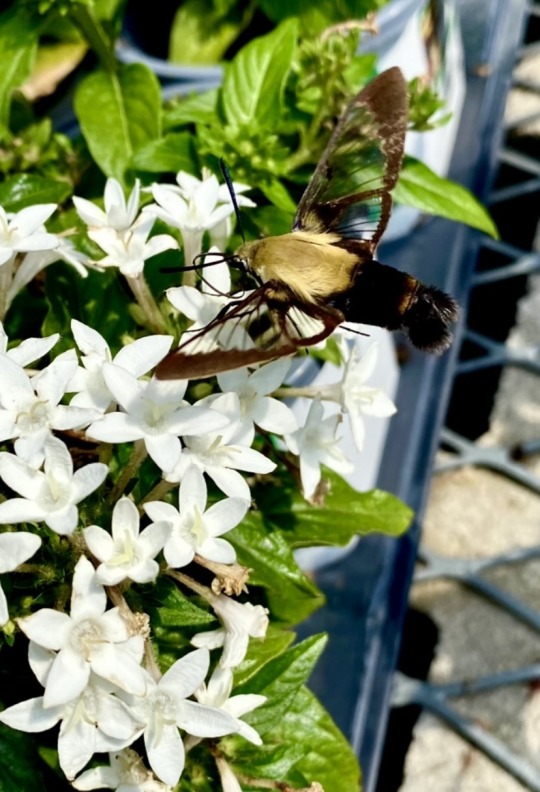
clear-winged hummingbird moth
with a bumblebee fly by🐝
32 notes
·
View notes
Text
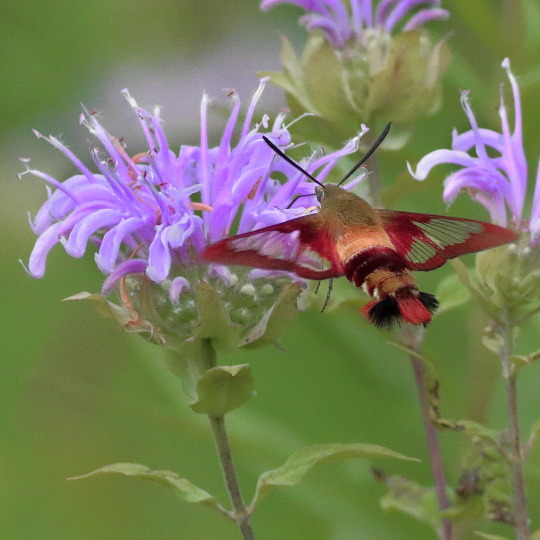
A Hummingbird Clearwing moth is a rare and amazing insect to see.
Not only is it just about as big as a hummingbird and behaves in much the same manner - floating in the air as they do, but if you look closely, its wings are indeed, clear.
Amazingly, even in flight you can see right through them.
Watching one is mesmerizing.
#midwest#summertime#moths#hummingbird clearwing moth#insects#wildlife#wildlife photography#insect#nature photography#insect photography#wildlife photos#bee balm#flying insects#insectblr
477 notes
·
View notes
Text
Sphingidae moth propoganda!!!
my favorite moth family because it just DOES NOT MISS. every single moth this family puts out is a win. contains such wonderful creatures as

the white-lined sphinx, which is about the size and shape of a hummingbird and hovers in midair to sippy from flowers

the elephant hawkmoth, which is colored like a frickin pokemon

the poplar sphinx moth, amongst which gynandromorphs are unusually common (intersex moths!), as pictured here

the oleander hawkmoth, which looks like someone spilled green and purple paint all over it and eats mostly poisonous plants

the gardenia bee hawkmoth, who imitated a bee so hard that their wings are clear and they got fuzzy butt pompoms

the narrow-bordered bee hawkmoth, who is doing much better at looking like a bee
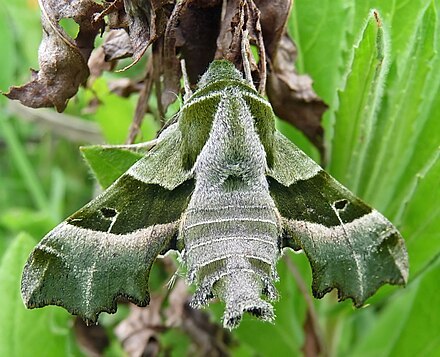
the willow herb hawkmoth, who looks so. perfectly green. love this thing

the levant hawkmoth, who’s got a sleek rose gold type coloration
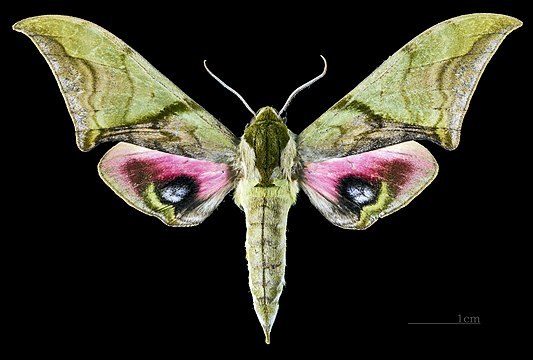
the eyes pink and green hawkmoth. the silhouette, the colors, the pattern. no notes
and of course, everyone’s favorite…
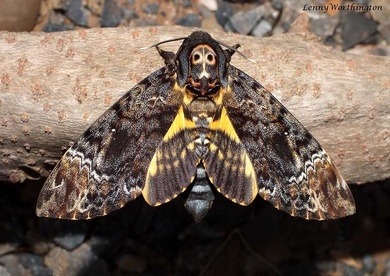
the delightfully goth death’s head hawkmoth
this little dude may be the icon of spooky fans everywhere but he also can bark!
many more lovely sphinx moths exist, and they can be found worldwide, so go. look up your local sphinxes. plant their favorite foods. and tell them you love them.
this message was brought to you by autism
128 notes
·
View notes
Text
Moth of the Week
Hummingbird Clearwing Moth
Hemaris thysbe
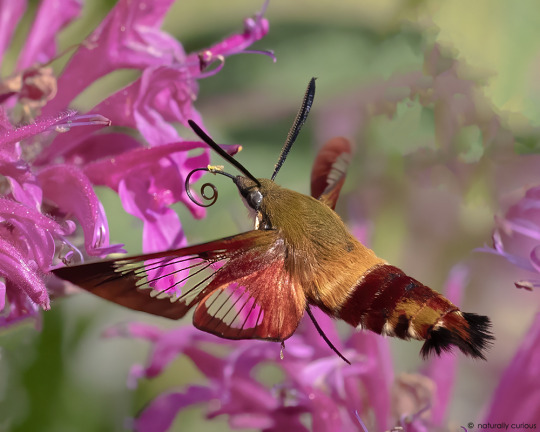
The hummingbird clearwing moth is a part of the family Sphingidae or the hawkmoth family and was first described by Johan Christian Fabricius in 1775. The name Hemaris Thysbe is thought to be a reference to Thisbe, one of the doomed lovers in Ovid's Metamorphoses, due to the color of Thisbe’s blood-stained scarf and the maroon color of the moth. Additionally, the name hummingbird clearwing is due to the humming noise created by the rapid flapping of the moth’s transparent wings.
Description The hummingbird clearwing moth typically has an olive green and maroon back with a white or yellow and maroon underside. It has pale legs and no stripes, which is how you tell this moth apart from other in its genus, Hemaris. Its wings are transparent with a maroon border. After hatching, the hummingbird clearwing’s wings are a fully opaque dark red to black. Then the wing’s scales fall off when the moth takes flight, resulting in a clear wing with maroon borders and visible veins. However, a moth’s color and wing patterning varies between individual moths. For example, moths born in the south or later in the mating season are darker in color, and different populations have varying wing border shapes.
Average wingspan of 4.75 cm (≈1.9 in)
Up to 70 wingbeats per second
Can fly up to 12 mph (≈19.3 kph)
Diet and Habitat When in their caterpillar stage, these moths eat the leaves of cherry trees, European cranberry bushes, hawthorns, dogbane, honeysuckle, and snowberry bushes. Adult hummingbird moths feed on the nectar from flowers such as the Wild Bergamot and beebalm, red clovers, lilacs, phloxs, snowberry, cranberry, blueberry, vetch and thistle. The hummingbird clearwing prefers purple and pink flowers. They use their long proboscis or feeding tube to collect nectar from the flowers while flying in front of it like a hummingbird.
The average proboscis is 20 mm (≈0.8 in)
These moths are the most common in southern Ontario and the eastern United States. Their habitat ranges from Alaska to Oregon in the west and from Newfoundland to Florida in the east. They migrate northward from April to August and southward in late spring and the fall. They inhabit forests, meadows, and suburban gardens.
Mating The hummingbird clearwing has two broods a year in the south, but only one in the north. Mating takes place in May and June as females attract males with pheromones produce from glands at the tip of the abdomen. Female hummingbird moths will lay 200 eggs that will hatch in only 6 to 8 days.
Predators Hummingbird moths and caterpillars in general are hunted by birds, mantids, spiders, bats. To help protect themselves, these types of moths resemble hummingbirds or bees to fool predators.
Fun Fact Adults hummingbird clearwing moths are most active during the hottest parts of the day and have no hearing abilities due to a lack of “hearing organs.”
(Source: Wikipedia, Life On CSG Pond, United States Department of Agriculture, Georgia Wildlife Federation, Beyond Pest Control)
#animals#bugs#facts#insects#libraryofmoths#moth#mothoftheweek#lepidoptera#Sphingidae#hummingbird clearwing moth#Hemaris thysbe
107 notes
·
View notes
Note
ooh do you have a favorite moth species or genre? I quite adore a lot of them, clearwings (sesiidae) are really cool to me, especially because I already love wasps so hymenoptera mimics are really cool to me. bonus point for hummingbird-mimicking hawkmoths that also have clear wings, just arent in sesiidae. Though I also really like rosy maple moths :D

omg I just looked up the clearwings THEY ARE ADORABLE 😭😭😭
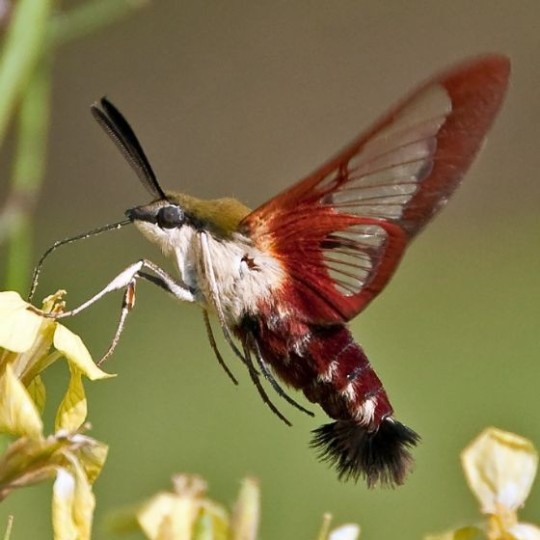
the resemblance!! even the coloration :'0 beautiful
one of my favs are the classic LUNA moths


I always adored the shape of their wings!! So majestic
besides them I also really really like those two
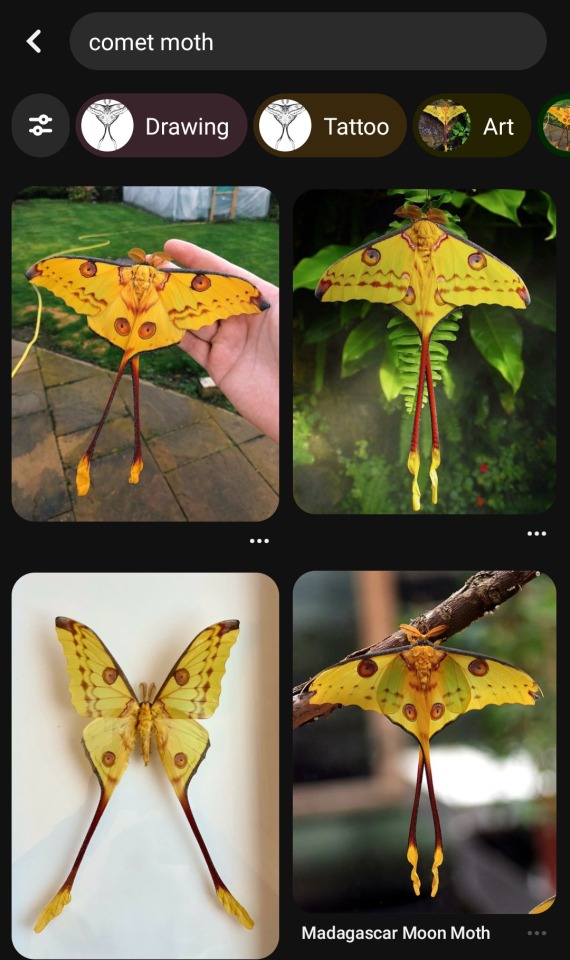

Madagascan moon moth and rosy maple
I just love them all, butterflies and moths I was in a butterfly garden couple months ago and it was a magical experience
12 notes
·
View notes
Text
In the Intag Valley of Ecuador, at this “most biodiverse hotspot on the planet” (the cloud forests of the tropical Andes), local communities have engaged in 30 years of sustained defense of environment and resistance to multiple mining corporations, including Canada’s Copper Mesa Corporation. The group Defensa y Conservación Ecológica de Intag has helped plant tens of thousands of trees while establishing about 40 different forest reserves. Now the planet’s biggest copper producer company (Codelco) is targeting the Intag region, with wells already drilled and important court cases scheduled for 2023. Among the many unique orchids, moths, hummingbirds, plate-billed mountain toucan, spectacled bears, mountain tapirs, critically endangered brown-headed spider monkey, and other creatures, in Intag Valley there are two species of frog which live nowhere else on Earth, previously thought to be extinct: the longnose harlequin frog and the newly-named “rana cohete resistencia de intag” (”Intag resistance rocket frog”). The frogs now provide “hope” and are the subjects of Intag’s pending court cases.
From January 2023, Mongabay provides a thorough report about Intag’s cloud forest ecosystems, community projects, and resistance to mining. Excerpts from their report below.
---


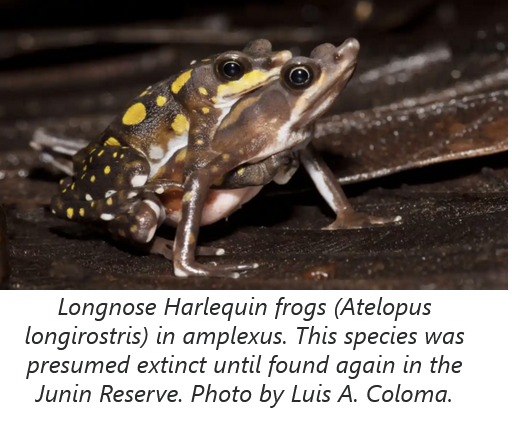






For nearly 30 years, communities have worked to conserve, restore and defend the cloud forests of the Intag Valley in Ecuador, in what locals say is the longest continuous resistance movement against mining in Latin America. The tropical Andes are considered the world’s most biodiverse hotspot, ranking first in plant, bird, mammal and amphibian diversity; however, less than 15% of Ecuador’s original cloud forests and only 4% of all forests in northwestern Ecuador remain. Codelco, the world’s largest copper producer from Chile, plans to open a mine in the Intag Valley that would destroy primary forest and lie within the buffer area of Cotacachi Cayapas National Park — a plan that experts say would be ecologically devastating and not worth the cost. Communities are using the presence of two threatened frog species — previously thought to be extinct — at the mining site to challenge the project [...].
In the 1960s, to encourage development, the government deemed forested properties with no human occupants “unproductive” and open to land grabbers. In turn, landowners were forced to clear at least 50% of the land to prove it was in use. These agrarian laws led to a flurry of deforestation that lasted into the 1990s. [...]
Pumas (Puma concolor), spectacled bears (Tremarctos ornatus), mountain tapirs (Tapirus pinchaque), mantled howler monkeys (Alouatta palliata), the critically endangered brown-headed spider monkey (Ateles fusciceps fusciceps), and the colorful plate-billed mountain toucan (Andigena laminirostris) are just a few of the more charismatic threatened species living here. [...]
Our first foray deep into this “terrestrial coral reef” is led by Roberto Castro, a local nature guide, environmental educator, and Zorrilla’s friend and neighbor. [...]
“Here is the Sangre de Drago tree … its red sap [is] a cure for many ailments,” he says. “Here is the Cecropia tree that lives in partnership with the ants.”
He shows us a white flower that shares its nectar with just one bat species and lets go of its seeds in a grand explosion once the nectar is spent. We see the sickle-winged guan (Chamaepetes goudotii), a large ground bird that lays only one, maybe two, precious eggs in a year. The famed Andean cock-of-the-rock (Rupicola peruvianus) cries out, its song somewhere between that of a parrot and a squealing pig. In the cloud forest, a single leaf is a stage for drama: ants farming aphids, lichens making their slow march against the moss. The forest drips with life.
We stop in a grove of massive elephant ear plants, twice as tall as a person. “These plants tell us water is abundant,” Castro says. The water trail leads us to a 10-meter (33-foot) waterfall. Castro stands in the stream below and pulls out a minuscule underwater castle made from pebbles.
“This is the home of moth larvae,” he shows us. [...]
Zorrilla and other community members started the environmental group Defensa y Conservación Ecológica de Intag (DECOIN) in 1995. [...] DECOIN helped communities establish 38 small-scale forest reserves that, altogether, protect almost 12,000 hectares (nearly 30,000 acres) of forest within the buffer zone of Cotacachi Cayapas National Park. [...]
In Intag, communities are self-defined administrative units, whose leader is nominated by its residents. It’s up to each community to decide how to best protect forests. Most include agreements prohibiting activities such as [...] cattle ranching, mining [...]. Bolaños and fellow community members planted more than 60,000 trees on slopes that were originally forests but had been converted to pasture decades ago. Working for six months each year between 2008 and 2013, dozens of community members planted 22 native species [...].
Intag’s richness aboveground is rivaled by a different kind of wealth below: copper. [...]
In 1996, the Japanese mining company Bishimetals, a subsidiary of Mitsubishi Corporation, found evidence of massive copper deposits in the Intag Valley. [...] In 1997, local communities reacted [...]. No one was harmed in the incident, but it was enough to make the company pull out. [...] After Bishimetals retreated in 1997, things calmed down until the Canadian mining company Copper Mesa Corporation (formally Ascendent Copper) entered the scene in 2004. [...] The company tried for five years to develop the project and used paramilitaries and violent force, Zorrilla tells Mongabay. [...] DECOIN helped residents file a lawsuit against both the mining company and the Toronto Stock Exchange for complicity in human rights violations based on Copper Mesa’s actions. [...] [I]n 2010 the Toronto Stock Exchange delisted Copper Mesa Mining Corporation.
---
Now, the communities face the world’s largest copper producer, Chile’s Codelco, which has partnered with Empresa Nacional Minera (ENAMI EP), Ecuador’s state-owned mining company, and invested millions into advanced mining explorations across Intag — in particular within the 5,000-hectare (12,400-acre) mining concession known as Llurimagua. [...]
According to several community members Mongabay spoke to, around 400 military and police officers used force to ensure the presence of Codelco and ENAMI in the mining concession. [...] Javier Ramirez was the president of the Junín community in 2014 when he was arrested for “sabotage and rebellion against the state.” [...] Codelco persisted and set up camp in the Junín Community Reserve, a patch of primary, old-growth forest [...].
Codelco has installed at least 90 drilling platforms within the reserve, digging down to depths of 1,200 meters (3,900 feet). [...]
The U.S. nonprofit Earth Economics [...] valued ecosystem services in Intag, such as water, food, climate regulation, soil retention, pollination, waste treatment, recreation, and scientific research, at $447 million per year in 2011. That’s higher than the projected revenue from copper mining in the region [...].
At the base of a waterfall, we stop to catch our breath, and Zorrilla steps forward. “This is close to where they found the frogs,” he says.
And here enters hope.
Among the dozens of threatened species in the tropical Andes, two have been found in this reserve and nowhere else on Earth: the longnose harlequin toad (Atelopus longirostris) and the Intag resistance rocket frog whose name was chosen through a contest. Both were presumed extinct until they were recently found again in the Junín Community Reserve. [...]
Finding these frogs has given the community a strong argument to try to legally stop mining development [...].
In September 2020, the Intag communities won one of the few cases upholding the rights of nature in the lower court. But the case was overturned in the higher provincial appeals court due to a procedural error. [...] The case is now before a three-member appeals court. After months of delay, a new judge was appointed in December. The new judge wants to have all of the evidence presented again, essentially starting the process over. The next court hearing is scheduled for Jan. 23 [2023]. [...]
We speak with Norma Bolаños about Mujer y Medio Ambiente (Women and the Environment), a group of nearly 50 women in Intag who make products out of cabuya, a fiber they produce from the agave plant, and color with natural dyes. [...]
In Cotacachi, we visit the home of Cenaida Guachagmira. She’s 28, the same age as the resistance movement, and has known this fight her whole life. [...] “The companies have their weapons and we have our dignity,” Guachagmira told Re:wild in an interview earlier this year.
---
Headline, images, captions, and all text published by: Liz Kimbrough. “In Ecuador, communities protecting a ‘terrestrial coral reef’ face a mining giant.” Mongabay. 9 January 2023. [Italicized heading and first paragraph in this post added by me.]
33 notes
·
View notes
Text
@hyperionsceo submitted: Howdy! My mom took this photo, so, I apologize if it isn't very clear for ID'ing purposes.
She and my dad saw this bug (on the flower in the bottom) in New Hampshire, but my dad is also confident he's seen this type of critter in Maine as well!
Any guesses on what it could be would be very appreciated ^_^ (also included a zoomed in version of the photo that was brighted a bit)

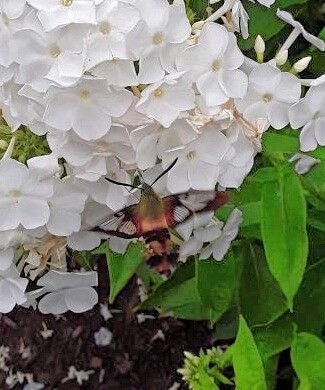
Hi! It’s a clearwing sphinx moth in the genus Hemaris, but I’d need a clearer photo to tell you for sure which one it is. It’s most likely either a hummingbird clearwing or a snowberry clearwing. The former is more red than the latter, but the latter’s wings can look reddish in certain light, so hard to say from these photos for sure! If I could see the legs I’d be able to tell you definitively. There are also two other moths in the same genus found in New Hampshire, so it potentially could be those, but the’yre much less common.
54 notes
·
View notes
Note
Glad you liked the snowberry clearwing suggestion! Big flashy ones like a lot of saturniids are somewhat hard to come by here (one of the more notable instances I've been able to find is the time someone found a cecropia cocoon in the woods and it ended up on the news because nobody who saw it initially knew what it Was lmao), so we've got a lot of smaller, less distinct (or at least less well known) ones - That clearwing is probably the most unique of them, but there's some others that are relatively notable, I think!
We've got a few sphinx moths - While at the mall this past summer, I had an encounter with a lettered sphinx, namely one with a reddish spot on the back like the one in sighting 1347349 on butterfliesandmoths (dot) org, but I would argue the one that leaves the most impression after the clearwing is the white-lined sphinx! They're another one that's fairly commonly referred to as a hummingbird moth, despite not being closely related to the hummingbird hawk-moth of Eurasia - A lot of sphinx moths around here have similar sizes and flight patterns to hummingbirds and also tend to hover around flowers when feeding, so they're all largely lumped in as "hummingbird moths" by casual observers, but the white-lined sphinx is probably the one most commonly referred to as such.
Outside of the sphinx moths, a REALLY distinct family we have here are the plume moths - They have a frankly bizarre shape to them, with a long, thin body almost more resembling a dragonfly than a moth in shape, and long, thin wings near the front of the body, so that, when at rest, they form an almost T shape. There's a few different species here, but the most common one I've seen is the morning glory plume moth - There's usually one or two hanging out on my front door during the warm months at night! Weird little dudes, they give me robber fly "what the fuck is that??? what IS that?????" vibes.
As far as smaller, less distinct moths go, there's a few here that are better known for their status as caterpillars than the moths themselves - We have both Isabella tiger moths and Virginian tiger moths here, better known as the wooly bear and yellow wooly bear in their larval forms, respectively! There's also the American dagger moth, which has a rather nondescript appearance as an adult, but a very distinct one in its larval form! As caterpillars, they've got a very dark face, and are covered in pretty vivid yellow yellow hairs, with a few black tufts that resemble spikes - There are some reports of skin irritation from their hairs, but they're seemingly non-venomous!
Another moth larvae that causes skin irritation, this time due to their hairs being toxic to humans, is the brown-tail moth! They're not native to the US, but there is a population in New England after they were introduced, and they've been particularly widespread where I live for the past decade - In 2018, the front wall of my then-workplace was absolutely COVERED in the adult moths, which are white with, as the name implies, brown tails (sometimes bordering on reddish). A few of them actually made their way into the building, and I brought them back outside - Interestingly, they lose the toxins in their hairs after they pupate, so adults don't cause a rash the way the caterpillars do! They used to be significantly more widespread through eastern North America, but they've declined for... not-fully-clear reasons, but one theory suggests that their population was suppressed by parasitic fly species introduced to counter ANOTHER introduced moth, the spongy moth (Whose scientific name is lymantria dispar! The name spongy moth is a relatively new one for it, so you may find more documentation using its scientific name than its common one. It was formerly known by another common name, but that name also happens to include a slur, so! I'm gonna make the choice to Not include that here 👍👍👍)! They've got some neat sexual dimorphism going on - In addition to the relatively common antennae size difference, males are a light brownish color, while females are a rather bright white with sort of rippled brown striping on the wings! I personally think the females stand out as more flashy than the males, which is neat to see, as someone who also gets a kick out of birds, where the opposite is often true - Usually in birds males are the ones with the more flashy plumage, or at the very least, females tend to have more spotted or mottled colorations in species with dimorphism, to help keep them more hidden while nesting. Even species with relatively little dimorphism beyond size tend to display this pattern - Common barn owls, for instance, can often be differentiated by spotting on the breast and the color of the feathering around the facial disc, where females tend to have heavier black spotting than males (whose breasts are often white with no spotting at all, though they get speckling occasionally) and also have darker facial disc feathers. (I follow an artist in the UK who has livestreams of the raptors that use the nest boxes in his garden, and he works alongside a rehabber who visits when their hatchlings get old enough - Some of the species he has are hard to differentiate even as adults by visual alone, but for barn owls, those are the standard ways of sexing owlets when they're getting their ID rings. But that's getting a bit off topic lol)
Anyway, the male spongy moths veer a bit in to LBJ territory, to borrow a birding term (LBJ stands for "little brown job" and is sometimes used by birders to refer to those fairly common brown birds that are difficult to distinguish - Trying to tell sparrows apart at a glance, for example), which is where a lot of the other moths here fall into. A lot of them aren't especially distinct, often various browns and greys - I'd say even that lettered sphinx I mentioned at the start probably falls into that territory if you're not as Normal About Bugs And Birds As Me. We do have one seemingly-LBJ moth that stands out off the top of my head, though - Amphipyra pyramidoides, or the copper underwing of the US (a distinct species from the copper underwing of the palaearctic), looks like a pretty unremarkable LBJ when its wings are folded up at rest, but as the name implies, the underwings have a distinct copper color that can be seen with their wings outstretched! Underwing moths have a bunch of species with that trait of colorful lower wings, highly recommend poking through them if you have a chance.
Anyway, that's a bit long, so TLDR: I'm Just A Touch Autistic and had a bit too much time at work with the snow this morning keeping customers away and yelling about moths is how I opted to spend the slow day, I suppose bfnfngmdngndn No pressure to read all of that if you haven't already, or to respond to it, naturally! I just get a kick out of cramming excessive amounts of words about bbugs (and bbirds) through my ISP's wires haha. Thanks again for the moths, and I'm glad to hear you're recovering well! And I gotta say, even if they're intended as a sort of quicker and easier, tiding things over while you're sick solution between the more detailed pieces (which are Very Good, for the record), I also love the ms paint moffs tbh. Iconic.
i don't know who you are anon but i love you thank you for putting an entire ass essay about moths in my inbox
i knew about a lot of these species (because i'm a nerd who does a lot of research about shit) but i didn't actually know about plume moths!! they look really cool, def gonna draw them at some point.
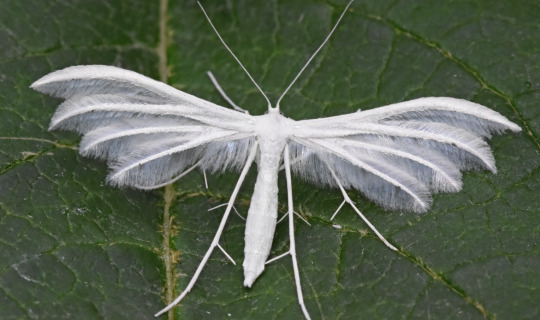
they remind me of like, dragon wings or bat wings
4 notes
·
View notes
Note
colorgenders inspired by the results of a “What is your Aura” quiz ((https://)uquiz(.)com/quiz/pxTx2D/what-color-is-your-aura):
Sky: short poems, teacups, clear skies, diaries, dripping icicles, tears, tennis shoes.
Honeysuckle: succulents, key lime, glow-in-the-dark stars, blown glass, honeydew, garter snakes, notes in bottles.
Seafoam: clear water, milkshakes, crystals, agave, candy dishes, converse, seashells.
Yellow: daisies, road signs, bumblebees, lemon meringue, bicycles, polaroids, awnings.
Hickory: felled oak, brass, sunken ships, olive pits, graphic shirts, splinters, dark room.
Orange: guitars, fanta bottles, sunglasses, orange peels, butterflies, popsicles, paper lanterns.
Sage: herb clippings, matcha, bullet journals, mini backpacks, needle felts, pistachio, laptop stickers.
Teal: dyed hair, scales, doc martens, aurora borealis, stormy seas, kingfishers, agate.
Royal (blue): crown jewels, portraits, satin chairs, masquerades, nebulas, betta fish, secrets.
Gold: lion statues, coins, gold leafing, bound books, goldfinches, crowns, heart lockets.
Crimson: rose vines, blood, apples, velvet, sharp nails, galaxies, dripping jewellery.
Navy: brush strokes, suit jackets, midnight, comforters, star gazing, arctic waters, starlings.
Forest: fern leaves, greenhouses, cloaks, bookstores, pine trees, chokers, snake scales.
honey: friendship bracelets, beehives, school buses, children's books, flower petals, honeyed toast, polaroids.
Ashen: old newspapers, smoke, quiet cities, pale cheeks, pebbles, chalk, the clouded moon.
Garnet: Brooches, anthologies, stained glass, leaves, dining chairs, long robes, curtains.
Chiffon: stone walls, sweaters, moths, dusty lace, animal tracks, incense, throw pillows.
Red: leather jackets, cherries, bruised knuckles, roses, lipstick, fast cars, rose petals.
Magenta: splattered paint, glitter, childhood friends, neon, pleather, dance floors, crystals.
Amaranth: bundled flowers, ribbon, merlot, overcoats, gemstones, lipstick prints, red velvet.
Periwinkle: knit hats, candies, tiny flowers, beads, teacups, washi tape, clouds.
Jade: islands, sketchbooks, rainy windows, pendants, puzzle pieces, tree frogs, sea glass.
Pink: cupcakes, sunglasses, pink sands, starbursts, pinky promises, flower crowns, ice cream.
Rose: lace, blown kisses, milk tea, paper fans, pillows, ballet slippers, fairy wings.
Amethyst: earrings, violet corts, parades, gemstones, insect wings, grape bushels, outer space.
Noir: drops of ink, eyeliner, crows, spiders, charcoal, painted nails, the night.
Cream: dandelions, marble, bottled coffee, hair ties, banana cream, bedsheets, sketches.
Beige: lattes, dry fields, footprints, easels, cat fur, pottery, fresh-baked cookies.
Pearl: abalone, perfume bottles, chandeliers, tulle, ball jointed dolls, satin, paint palettes.
Bronze: leather books, cowboy hats, foxes, candle jars, sword hilts, cobblestone streets, hourglasses
Amber: autumn days, freckles, torches, cabins, fossils, unbrushed hair, enamel pins.
Fire: sunrises, woven blankets, campfires, tigers, whiskey, monarchs, road trips.
Purple: geodes, club lights, ferris wheels, sunglasses, hummingbirds, eyeshadow, outer space.
Blush: lollipops, warm cheeks, lip gloss, flowers, flamingo feathers, painted nails, heart glasses.
finally done with all of these — they're queued!
6 notes
·
View notes
Note
top 5 moth
ohoho yes let’s go.
1. cecropia moth i love her. she’s big and red. and so pretty.
2. listen a luna moth IS second on this list. she’s very beautiful and very important and i love her.
3. rosy maple moth. she’s so pretty i love her.
4. hummingbird clearwing moth. what’s up with that guy! he’s a hummingbird themed moth! with clear wings!!!
5. polyphemus moth who is doing it like her. she’s fluffy she’s got pink she’s got stylish eyespots let’s go!!!!!!
4 notes
·
View notes
Text
moth acrobatics
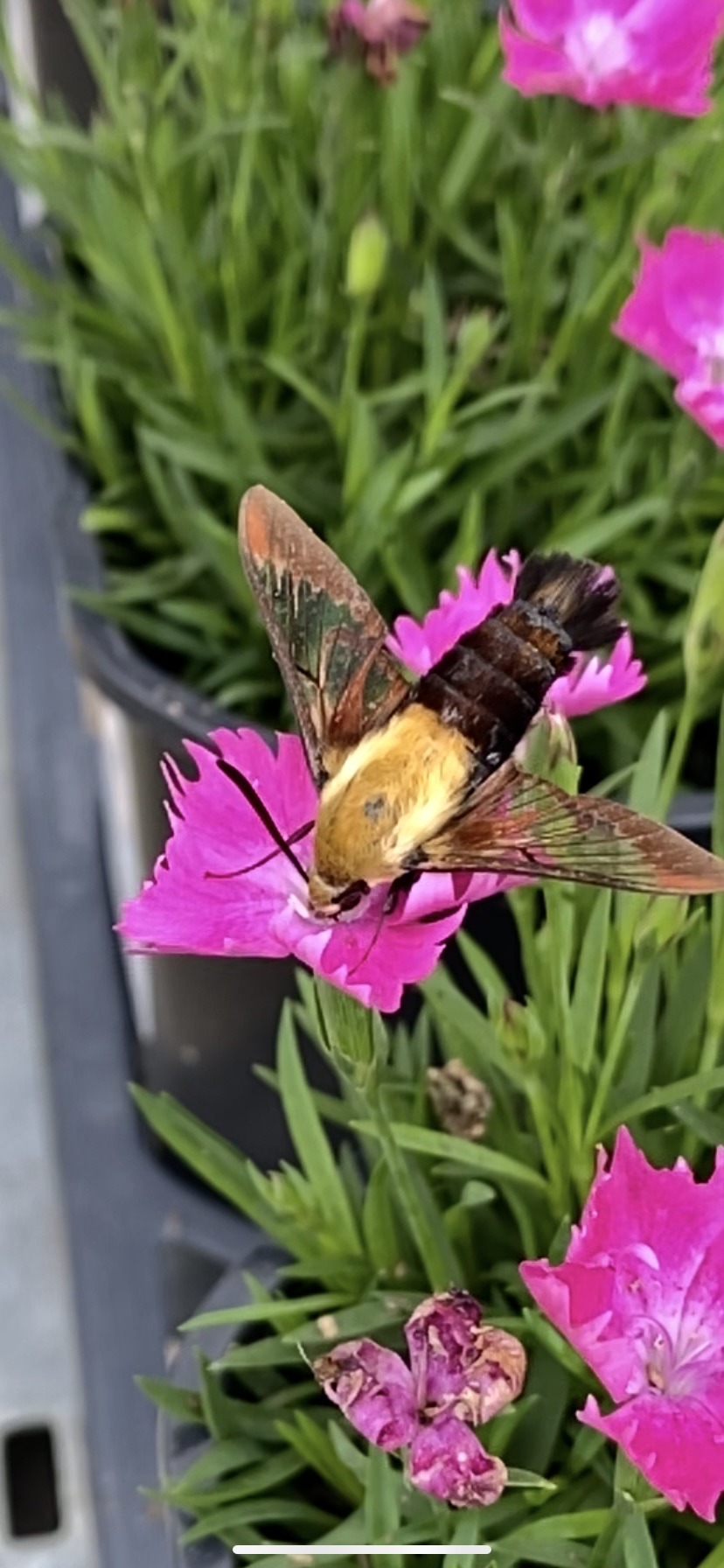
17 notes
·
View notes
Note
for that ask game: kanaya maryam (obviously) and jake english <3
grimAuxiliatrix [GA] began trolling diamondringsandGutterbones [DG]
GA: The Closest Green Item To Me Well Id State My Blood But I Suppose Thats Not An Item
GA: ...
GA: Either My Black Razer Kraken Kitty Headset With Jade And Teal Coloring For The Lights My Ornate Flowery Bedding With Hummingbirds An Evergreen Tree Or Jade Dress
GA: Because Youre So Cool Ill Answer The Other One For Me About My Most Loved Articles Of Clothing
GA: My Favorite Hat Is A Sangria Bowler Hat With A Gold Stemmed Rose With Black Petals And Jade Peacock Feathers Attached
GA: My Newly Acquired Green Tinted Prescription Glasses Quite Similar To Toastiedrawz Depiction Of Me
GA: My Favorite Mask Has Evergreen Trees
GA: My Favorite Eyepatch Has A Null Symbol On It
GA: My Favorite Jacket A White Blazer
GA: My Favorite Bra Teal Laced Geometrics
GA: My Favorite Swim Top Teal Mermaid
GA: My Favorite Collar Is Teal Trimmed Jade Leather With Black Spikes And Heart Lock
GA: My Favorite Wings Are Galaxy Butterfly With Deep Purples
GA: My Favorite Gloves Three Quarter Arm Neon Red Latex
GA: My Favorite Top Is Ivory Turtle Neck Crop Top With Bosom Window
GA: My Favorite Dress Low V Cut Deep Shimmery Jade With Full Back Zipper But Huge Back Windows From Back Of Shoulders To Top Of Hips And Short Hemmed
GA: My Favorite Skirt Geometric Design Blood Red Ankle Length With Pockets Just Missing The Pearls To Be Identical To My Usual Skirt
GA: My Favorite Heels Are Hot Pink Six Inchers With Toe And Ankle Strap Only
GA: My Favorite Socks Are My Thigh High Jade And Teal Tentacle Socks On Purple Background
GA: I Only Own One Merfolk Tail But Its An Orange Similar To Tiger Moths With Plum Purple Tips
GA: ...
GA: I Simply Love Fashion No One Asks About It So This Was Lovely Getting A Chance To Share Some Of My Ostentatious And Extravagant Pieces
GA: ...
GA: Okay Lets Describe My Greatest Adventure
GA: Two Birthdays Ago I Visited The Pacific Ocean For The First Time In My Life
GA: A Solo Camping Trip At An Official Park I Stayed In A Cabin For Two Nights Exploring There For Three Days
GA: It Was Halloween Weekend Exceptionally Moderate And Clear Weather
GA: Freshest Air Ive Ever Experienced Before
GA: So Much Sunlight
GA: Plenty Of Mushrooms Pretty Scraggly Trees
GA: Exceptionally Windy Beach Flat As Could Be Gorgeous Dunes To Walk Over A Deafening Silence
GA: The First Night I Was Overcome By Horror Terrors As Per Usual
GA: I Walked To The Beach At Four In The Morning Feeling Smaller Than Ive Ever Felt Beneath The Expansive Clear Night Sky Waves Sparkling Like Silver Realizing Im Safe Alone Exploring This Universe Understanding It Gave Existence To Something As Small As Me So I Can Simply Enjoy It Because I Matter To Myself And It Was The First Time In My Life I Felt Whole
GA: Made Myself Good Food Successfully Made My First Campfire By Myself The Second Night Set Up Halloween Decorations Swam In The Pacific And Listened To The Birds And Breeze And Waves Soaking Up The Sun And Being Content With Existing Gaining A Hope To Share That With Someone Someday
grimAuxiliatrix [GA] ceased trolling diamondringsandGutterbones [DG]
#A Pyre For My Auspicious Passion#Kanaya Maryam#When I Consider Vriskas Cerulean Blood#Sylph Soars On Wings Of Moth#A Certain Madness Im Afflicted By#I Feel As Though This Conversation Has Utterly Outmaneuvered My Constructive Involvement#Rainbow Drinkers And Flora Basking Beneath The Blistering Alternian Sun As One#Mcfussyfangs Zeal For Designing Fanciful Fabrics
3 notes
·
View notes
Text
moth names part 1
because. list source (x)
an / ann - annulet
antler
apple
argent
ash - ashworth
arch / arche - arches
bar - barb - barber - barberry
barred
beau - beauty
belle
belt
bird
blair
blood
blot - blotch / blotche - blotchy
blox - bloxworth
blu / blue / bleu
bord - border
box
bri / bry - bright / brite - brighton
brown
brim - brimstone
brin / bryn - brind - brindle
braud - broad
bee / bea
buff - buffy
bur / burr - burn / byrn / byrne - burnet / burnett / burnette
brass
button
blush
car - carpet
cher / cherr - cheri / cherry
canary
case
chalk
chestnut
chim - chime - chimney
choco - chocolate
cin / cinn - cinna - cinnabar
cis - cist - cistus
clan - clance - clancy
clif - clifden
cloa - cloak
clou - cloud
cream
crims - crimson
cur / curr - currant
clear
clove - clover
dark
death
dec - dece - deca - deco - decem / decemb - december
dew - dewick
dingy
dot / dott
drab
drink - drinker
dusk - dusker - dusky
dag - dagger
ermine
em - emer - emera - ermeral - emerald
eye
earl - early
el / ele / elle - elephant
em - emp - emper - emperor
es / ess / esse - essex
es - est - estu - estua - estuar - estuari - estuarin / estuarine
egg - eggar
for - forest / forrest - forester
fea - feath - feather
fest - festoon
fier - fiery
fire
fish - fisher
five
flame
four
fox - foxglove
frost
goth - gothic - gothica
grey / gray
green
gal - gali - galia - galium
gar - gard / guard - garden - gardenia
ghost
goat
gold
grass
glory
hook
hawk - hawkmoth
heath
honey - honeycomb
haw - haworth
heart
horn - hornet
hum / humm - hummer - humming - hummingbird
jersey
july
knot
ken - kent - kenti - kentish
Lune - Luna - Lunar
leaf
line
lute - lutestring
loop - looper
lack - lackey
lace
lappet
lattice
lead
leo - leopard
lichen
lime
liquor - liquorice
moth - mothy / mothie - mothica
mocha
magpie
maid - maiden
manchester
map
mar - marble
march
mer - merv / merve - merveil / merveille
mint
mist - mistle - mistletoe
mot / mott
narrow
net / nett
north - northern
nov / nove - nova - novem / novemb - november
ora / aura - oran - orange
Pine
per / par - pareil
plume
plus - plusia
pug
pier - pierce - piercer
pearl
quake - quaker
rust - rustic
riv - rivu - rivul - rivulet / rivulette
red
shade
sable
skel - skele - skeleton - skeletonizer
stripe
straw
snout
silver - silverline
sweep - sweeper
swift
spot
speck
shell
swallow
tooth
tree
tail - tails
thor - thorn
tiger
treble
umber
vein
wing
white
wave
wane / wain - wainscot
wax
yellow
#moth names#types of moths#names from#names from moths#name suggestions#read dni#name ideas#name lists#name blog#read my dni#name request#name inspiration#baby names#gender neutral names#fleur speaks
11 notes
·
View notes
Text
You know ... Yeah, usually I am a stickler for "say what you mean and mean what you say"- especially when it comes to using correct terminology for things that we have well defined terminology for. But it gets very exhausting having to constantly correct people who want to play the very stupid game of pedantic semantics over the use of the name "Hummingbird Moth" in my local gardening groups every five dang seconds like it's some kind of an Olympic Sport.
You do not get to yell at people calling Tomato Hornworms (Five-Spotted Hawkmoths) "Hummingbird Moths" ... White-Lined Sphinx Moths are not the only member of the Sphingidae moth family that get to be called a "Hummingbird Moth" just because it's the one that's most commonly called that here in Oklahoma. Especially when "Hummingbird Moth" isn't even in its name anyways; if that were a true prerequisite, then only the Clear-Wing Hummingbird Moth would actually get that honor here.
The names "Hummingbird Moth", "Hawk Moth", and "Sphinx Moth" are all completely appropriate and accurate colloquial names for the entirety of all near 1,500 species of the Sphingidae family of moths. That's literally how Folk Names work. You're going to have to learn how to deal with that and stop being an asshole to people.
#Friend Finds#Gardening#Domestic Witch#Domestic Witchcraft#Green Witch#Green Witchcraft#Cottage Witch#Cottage Witchcraft#Verderer#Oklahoma#Personal#2023#Prairie Magic & Medicine
1 note
·
View note
Text
the world is so amazing
there are SO MANY different moths that are all called hummingbird moths!!! there's so many big moths!!!!!!! and i LOVE them all 💜💜💜💜💜💜 the white-lined sphinx moth is one of the prettiest, but there's also an entire genus of moths (Hemaris) that have partially CLEAR wings!!! that is SO COOL!!!!!
#key speaks#i have decided to look more into moths tonight and i am SO HAPPY#MOTHS!!!!!#my beloved <3#i REALLY wanna pet them
1 note
·
View note
Note
For the doodles if you're still doing them, maybe a creature based on hummingbird moths! Or any of my cores only if you're in the mood!!
Hummingbird moths are the goofiest little things and I adore them and their silly little shrimp tails. :D So uh. I just drew a straight up hummingbird moth, because they are cute and soft as-is and I didn’t feel like redesigning that.
Also drew an angry Calidyte, because she seemed like she’d be fun and satisfying to scribble out with my fountain pen! I was correct.

[Image description: Marker and pen doodles on a journal page. One doodle is a green and red hummingbird moth; the other is a one-eyed alien in a lab coat. End ID.]
Thanks for the doodle prompt!
#missed on the wings a bit whoops they should attach further down. ah well.#I was so very confused the first time I saw hummingbird moths in our garden. I’d never seen anything like them before!#with the aforementioned goofy shrimp tails and the clear panels in their wings and just#everything ahah#art#hummingbird moth#bugs#calidyte#other people’s ocs#doodles#novamoth#answers#art prompt fills#my art#my stuff#gift art
5 notes
·
View notes